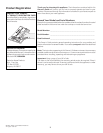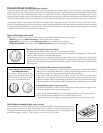
7
Ceramic Glass Cooktop (some models)
The ceramic-glass cooktop has electric heating coils located below the ceramic glass surface. The design of the glass cooktop
outlines the area of the surface heating unit below. Most importantly, make sure the diameter of the pan matches the diameter
of the surface unit. Heat is transferred up through the surface of the cooktop. Only flat-bottomed pans should be used. The type
and size of the cookware, number of surface units in use and the settings of the surface units are factors that will affect the amount
of heat that will spread to areas surrounding the units. The areas surrounding the units may become hot enough to cause burns.
The cooktop should not be used as a cutting board or work surface. Dropping heavy or hard objects on the cooktop may crack it.
Pans with rough bottoms may scratch the cooktop surface. Placing foods directly on the smoothtop surface (without cooking utensils)
is not recommended as difficult cleaning will result and foods may smoke and cause a potential fire hazard. Never use the griddle
or similar cooking sheet on the ceramic glass cooktop.
Types of heating units used
Depending on model, three types of heating units may be found under the ceramic glass cooktop:
– Regular (single coil) radiant elements of various diameters or shapes.
– Expandable type (double circuits) radiant elements of various diameters or shapes.
– Bridge Expandable type (triple circuits) radiant elements of various diameters or shapes.
Regular radiant elements (some models)
The ceramic glass design shows the location of the heating surfaces.
Control knobs are used to set the heat power levels; knobs need first to be pressed in when at OFF
position, then turned to the desired heat settings.
A glowing red surface unit extending beyond the bottom edge of the cooking utensil indicates the
utensil is too small for the unit. The control knob does not have to be set exactly on a particular mark.
Use the marks as a guide and adjust the control knob as needed. The hot surface and surface indicator
lights will glow.
Expandable radiant elements (some models)
This heating unit combines the characteristics of a small and a large regular radiant
heating unit. Its principal advantage is to allow small and large utensils to be used on
the same heating unit, therefore increasing the cooktop flexibility.
Heat power levels are adjusted by a special control knob that has a dual set of
graduations; for small utensils use the small graduations; the inner surface only will be
heating. For larger utensils use the larger graduations; the whole surface will be heating.
The hot surface and surface indicator lights will glow when the heating unit is turned ON.
Bridge Radiant elements (some models)
Its principal advantage is to allow you to create larger cooking zone for larger pan such
as roaster, griddle or some other specialty pans.
For the bridge element operation, use the larger graduations on the control knob.
For full bridge element operation turn on the rear element also.
To operate only the front element, use the small graduations on the control knob.
Hot Surface Indicator Light (some models)
Some models have an indicator light located on the ceramic glass cooktop that glows as soon as
the glass begins to warm up. When the heating unit is turned off, it will continue to glow as long
as the glass remains warm enough to cause burns. Other models have a hot surface indicators per
element arranged in a cluster. Their location is as shown in the illustration.
(Typical 30" cooktop shown)
Control Knob For Expandable
and Bridge Elements
The surface control knobs shown
below may not look identical to the
surface control knobs on your appli-
ance; it is only representational.
OFF
HI
8
7
6
5
4
3
2
1
HI
8
7
6
5
4
3
2
1


















